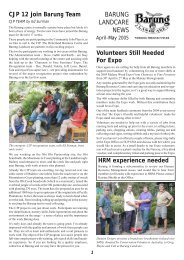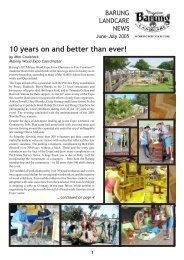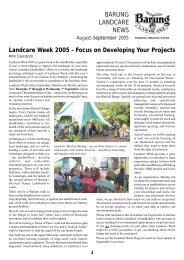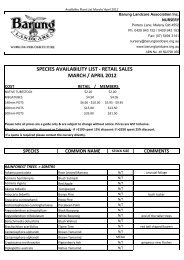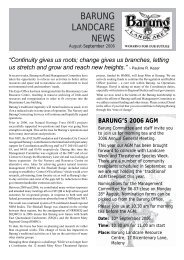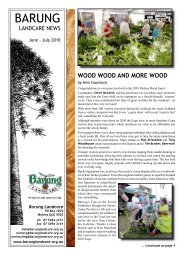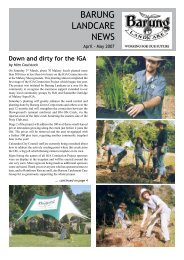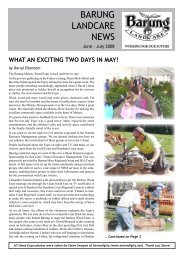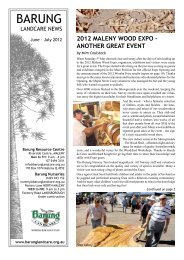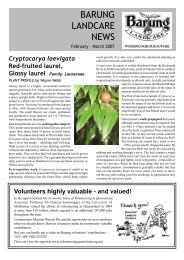Create successful ePaper yourself
Turn your PDF publications into a flip-book with our unique Google optimized e-Paper software.
Thinning and Pruning<br />
THE ORNAMENTAL GARDEN by Joan Dillon<br />
Every garden, presumably even a modern minimalist garden, will<br />
need thinning, pruning, perhaps re-cre<strong>at</strong>ing, <strong>at</strong> some stage in its<br />
life. Good initial planning will reduce the scale of the task, but<br />
few plants obey their label guidelines, and some will eventually<br />
domin<strong>at</strong>e. Large botanic gardens also undergo some level of<br />
reconstruction as time passes. You are not alone!<br />
So, time has passed, and decisions have to be made about which<br />
plants to prune and which to remove altogether. Everyone makes<br />
mistakes, or more accur<strong>at</strong>ely, unforeseen errors, (see label<br />
guidelines above) but it’s still like losing treasured friends! It’s<br />
quite common practice to initially overplant to gain quick cover<br />
but an appropri<strong>at</strong>e altern<strong>at</strong>ive would be to plant sacrificial<br />
groundcovers to fill in the early spaces. Good candid<strong>at</strong>es are the<br />
various scaevolas, Brachyscome multifida (available in several<br />
colours), the cheerful bright yellow hibbertias (especially<br />
Hibbertia vestita), and Helichrysum ramosissima.<br />
Densely planted gardens which protect the soil, shade out weeds<br />
etc will need thinning <strong>at</strong> some stage. Pest and/or disease problems<br />
may also be a reason for thinning. These can develop in very<br />
humid conditions when there’s not much air circul<strong>at</strong>ion and foliage<br />
remains moist. Disease, however, is not normally an issue with<br />
local n<strong>at</strong>ive plants growing in their own environment as problems<br />
mostly occur with plants already under stress.<br />
Too much shade, or sun, poor drainage and sudden changes in<br />
soil moisture levels, and being well outside the n<strong>at</strong>ural clim<strong>at</strong>ic<br />
zone, are common causes of stress and sometimes de<strong>at</strong>h. I did try<br />
a couple of potentially beautiful arid zone emu bushes but a heavy<br />
clay soil and humid SEQ really wasn’t for them! The birds loved<br />
them during the one season they flowered but they were stressed,<br />
the local insects came in droves, and I finally pulled them out.<br />
Seasonal pest <strong>at</strong>tacks can often be ignored since the plants recover,<br />
but if a particular specimen demonstr<strong>at</strong>es a tendency towards insect<br />
infest<strong>at</strong>ion and therefore the need for regular control measures,<br />
remove it. Life is too busy to deliber<strong>at</strong>ely cre<strong>at</strong>e unnecessary work.<br />
Some leptospermums will be <strong>at</strong>tacked by scale and then <strong>at</strong>tract<br />
sooty mould if they become shaded out by adjacent shrubs. In<br />
order to maintain a healthy and therefore <strong>at</strong>tractive garden, either<br />
the leptospermum goes, or its neighbour.<br />
Another pest which can cause problems and result in selective<br />
plant removal is the web-forming c<strong>at</strong>erpillar which stitches<br />
together very small leaves leading to defoli<strong>at</strong>ion. Candid<strong>at</strong>es for<br />
<strong>at</strong>tack are certain leptospermum and baeckia cultivars. Enjoy them<br />
for a while and then remove them to cre<strong>at</strong>e space which will rapidly<br />
be filled by adjacent, larger leaved and less susceptible shrubs.<br />
If you want your garden to remain ne<strong>at</strong> and tidy (controlled?),<br />
then regular pruning will be the order of the day. This should be<br />
programmed in from Day One to maintain dense foliage and<br />
promote flowering. Many n<strong>at</strong>ives, especially the callistemons,<br />
respond to tip pruning but sprawlers such as midyim (Austromyrtus<br />
dulcis) can be hacked back quite severely. Once the root system<br />
has been established, many melaleucas, particularly Melaleuca<br />
thymifolia, will come back from a stump.<br />
Don’t forget th<strong>at</strong> our small-leaved syzygiums and Austromyrtus<br />
cultivars such as ‘Blushing Beauty’ can be hedged and even used<br />
for topiary, if you’re into th<strong>at</strong> sort of thing. Lemon myrtles can be<br />
pruned, and have to be when grown as an orchard crop tree. N<strong>at</strong>ive<br />
mulberry Pipturus argenteus can be pruned hard and will cre<strong>at</strong>e a<br />
dense protective cascade of foliage on the edge of your<br />
reveget<strong>at</strong>ion areas. Don’t be afraid to prune but a regular light<br />
haircut is likely to give the best results.<br />
10<br />
The ‘Doing’ <strong>at</strong> <strong>Barung</strong><br />
THE CORNER DESK by Darryl Ebenezer<br />
The tree’s branches sway<br />
The leaves ripple in the wind<br />
The trunk sits quite still (Anonymous)<br />
Having become an active and quite literal participant in the ‘tree<br />
change’ movement I have now begun to notice and learn about<br />
things within the n<strong>at</strong>ural and built environments th<strong>at</strong> I would have<br />
previously glossed over or just plain missed. I have spent the first<br />
two months of my new role as Oper<strong>at</strong>ions Manager within <strong>Barung</strong><br />
integr<strong>at</strong>ing a whole new way of thinking and doing into my<br />
previous experiences and practices.<br />
A lot of ‘doing’ happens within <strong>Barung</strong> and the wider community:<br />
• Potting many hundreds of tubes each week out the back of the<br />
Nursery and helping to keep the office under control is an<br />
integral aspect of <strong>Barung</strong>’s success and s<strong>at</strong>isfying for the people<br />
involved (Volunteers)<br />
• Supplying 9500 thousand n<strong>at</strong>ive tubes to be planted into the<br />
local environment does make a difference (<strong>Barung</strong> Nursery)<br />
• Working five days a week clearing weeds and planting n<strong>at</strong>ive<br />
veget<strong>at</strong>ion does change the landscape for the better (<strong>Barung</strong><br />
Contracting)<br />
• Providing advice and an opportunity for people to grasp a<br />
vision of wh<strong>at</strong> is possible in their backyard is enormously<br />
valuable (<strong>Barung</strong> Reveget<strong>at</strong>ion and Habit<strong>at</strong> Officer)<br />
• Particip<strong>at</strong>ing in the educ<strong>at</strong>ion and training of Green Corp and<br />
CJP participants contributes to the life experience and future<br />
of these individuals and the whole community<br />
• Planning and implementing an opportunity to display the many<br />
facets of wood and sustainable living will change people’s<br />
<strong>at</strong>titudes and the way the environment is viewed (<strong>Barung</strong><br />
Maleny Wood Expo).<br />
As you can see, plenty of activity occurs each day and week in the<br />
life of <strong>Barung</strong>.<br />
All healthy organis<strong>at</strong>ions need to ensure th<strong>at</strong> both their activities<br />
(such as I have mentioned above) and their maintenance functions<br />
are <strong>at</strong>tended to.<br />
Part of my new role is to <strong>at</strong>tend to these ‘maintenance’ functions.<br />
Areas such as healthy rel<strong>at</strong>ionships, good communic<strong>at</strong>ion<br />
processes, good governance, sound fiscal management, and a<br />
shared vision of where the organis<strong>at</strong>ion is heading.<br />
I have enjoyed planting one tree (many thousands more to go),<br />
visiting a creek for a meeting, and learning about seeds and weeds.<br />
A gre<strong>at</strong> place to work and make a visible difference. In the next<br />
newsletter some thoughts about good governance and a shared<br />
vision.<br />
BARUNG MEMBERSHIP RATES<br />
Individual / family membership $ 20 pa<br />
Business membership $ 55 pa<br />
Business sponsorship $275 pa<br />
Don<strong>at</strong>ions of $2 or more are tax deductible.<br />
When your BUSINESS supports <strong>Barung</strong> <strong>Landcare</strong>, you will be<br />
acknowledged in the bimonthly <strong>Barung</strong> <strong>Landcare</strong> News (750<br />
distribution) and <strong>at</strong> <strong>Barung</strong> displays, and you are entitled to three<br />
free trees and discounts on plant purchases <strong>at</strong> the Nursery.<br />
Contact the office <strong>at</strong> <strong>Barung</strong> <strong>Landcare</strong> on 5494 3151 or email<br />
barungadmin@big.net.au for a Business Sponsor form.



